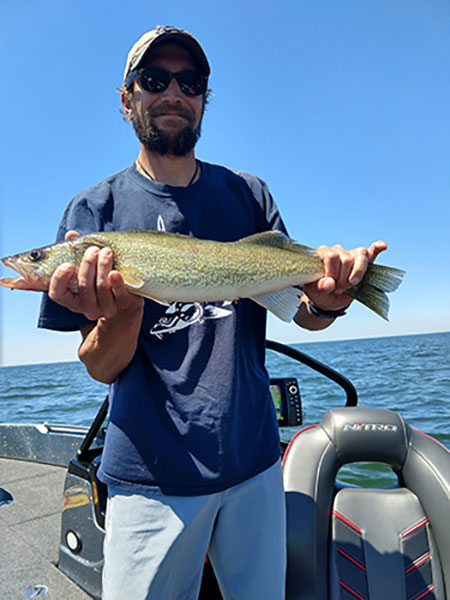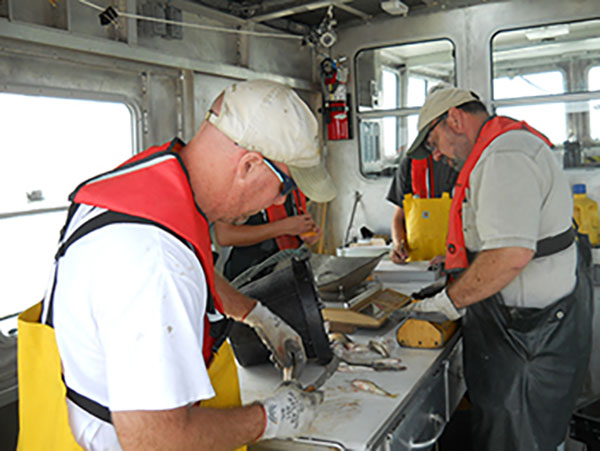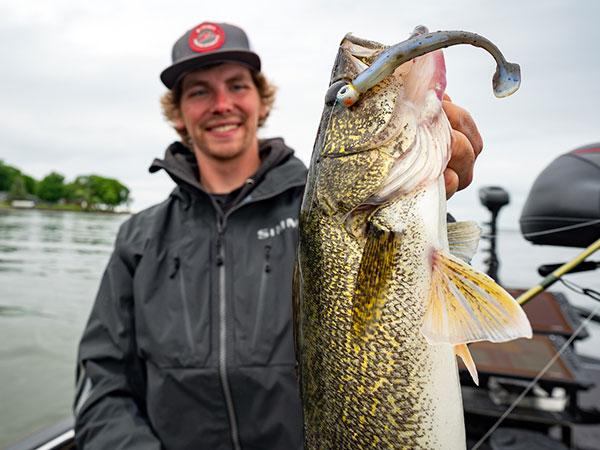- Details
MDNR Report
 Saginaw walleye
Saginaw walleye
Effective Jan. 1, 2023, the possession season for walleye will be open year-round on the lower Saginaw River in Bay and Saginaw counties from the mouth of the river, upstream to West Center Street (Douglas G. Schenk) Bridge.
The same regulation is in effect on the Lake Huron waters of MH-4 (see page 20 of the 2022 fishing guide) including Saginaw Bay. The daily possession limit for walleye remains at eight walleye with a 13-inch minimum size limit on these same waters.
The Michigan Natural Resources Commission approved this regulation Dec. 9, 2021, to increase fishing and harvest opportunities on the Saginaw Bay walleye population. Prior to this new regulation, the season used to close March 16 and reopen the last Saturday in April.
- Details
MDNR Report
 DNR Biologists
DNR Biologists
Based on the 24 trawl tows and 16 gillnet lifts conducted in September by the Department’s R/V Tanner and Channel Cat, initial findings indicate few changes to the Saginaw Bay fishery.
Overall, a total of 24 different species were collected by trawling and 27 different species were collected by gillnetting, with no new species collected.
Walleye abundance appears strong, and there are large year classes being documented from 2021 and 2022. Observations of a strong 2021-year class were supported by a large catch of juvenile walleye ranging in size from 10 to 12 inches. The evidence supporting the predicted strong 2019-year class will have to wait until all specimens can be aged in the laboratory this winter. Overall, the mean catch of larger walleye in gillnets (36.6/net) was slightly higher than the average (33.8/net) since 2003. The mean catch of young-of-year walleye in trawls was the highest since 2009, and second highest ever, indicating young walleye production remains very high.
- Details
MDNR Report
Lake Erie is one of the most popular fisheries in our state as it accounted, in 2021, for 14% of the total Great Lakes angling effort, 31% of the catch, a catch rate three times the other Great Lakes waters combined, and an angling intensity more than 54% that of the other Great Lakes waters in our state.
Fisheries surveys and other companion surveys are critical to maintaining this fishery, which Michigan shares with New York, Ohio and Pennsylvania and the Canadian Province of Ontario.
The DNR does two surveys using the R/V Channel Cat to obtain information from Lake Erie’s complex fisheries community:
- The first is a bottom trawl survey that examines the number of young-of-year walleye and yellow perch in Michigan waters of Lake Erie, contributing to interagency knowledge about reproduction for these two species. This survey, in its ninth year, also documents the relative abundance of forage fish species that live near the bottom.
- The second survey is a gillnet survey that samples the abundance and age structure of yearling and older walleye in Michigan waters. These data drive the population models that are used to determine the total allowable catch and daily bag limits for walleye in this valuable water. This survey was conducted in October at four locations with two index stations (Stony Point and Luna Pier) that have been sampled every year for 45 years.
Walleye populations remain near the all-time high, with trawling indicating that recruitment continues to be very strong. The age-0 walleye catch rate in the bottom trawl (14 fish caught per 10-minute trawl tow) was comparable to the past two years, coming in above the nine-year average of 11 fish per 10-minute trawl tow. Walleye reproduction during the past seven years has been strong, with multiple large year classes beginning in 2015.
- Details
Z-Man Report
 Z-Man walleye pro Dylan Nussbaum
Z-Man walleye pro Dylan Nussbaum
A self-confessed “bass angler for walleyes,” young Z-Man walleye pro Dylan Nussbaum has helped popularize an exciting, interactive approach to his favorite species. “For me, it’s all about solving the mysteries of finding and catching walleyes,” contends the Pennsylvania based tournament champ. “Every day is a different challenge, and that, to me, is a lot of fun.”
Nussbaum recently reflected on fishing strategy with forward-facing sonar (FFS). Recognized for his talents at actively casting artificial lures and soft plastics from the bow of his boat, Nussbaum offers compelling perspectives on what has become the biggest trend in freshwater fishing today . . . sonar “sight fishing.”
Z-Man: When did you first start using forward facing sonar (FFS) for your walleye fishing?
Dylan: I got my first unit—a Lowrance Active Target—about two years ago. If I’m up casting from the front deck of my boat, I’m using FFS one hundred percent of the time. The more I use it, the more I learn about fish and their real-world response to my lure. It’s pretty addictive. (laughs).
Z-Man: Tell us about your on-water learning curve with FFS.
Dylan: For me, it didn’t take long—maybe two or three outings—before I started figuring things out relative to fish species ID and seeing my lure on screen. These units are pretty intuitive and easy to use, especially once you see what a walleye looks like on screen and then confirm its size once the fish is in the boat. A walleye or a bass tends to paint a pretty solid image. But a carp or a muskie, for example, can look a little grainy on the screen. Walleyes generally (though not always) move within a foot or two of bottom. They typically move and react to your lure just a little slower than a bass, for example.





